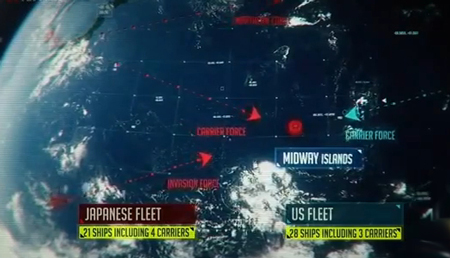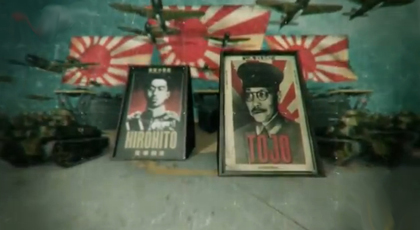
 |
|
|
|
WWII From Space is the latest attempt by The History Channel to wring new programming out of a subject long since exhausted. Good documentaries are still to be found at the cable channel, but much of THC has gone the way of reality programming. Show content is now not just enhanced, but driven by gaudy re-enactments and modern computer graphics. A trailer for a recent History Channel offering, for instance, casts handsome young actors as big American industrialists, running roughshod over "the rules" while "building America." After getting past the misleading title, WWII From Space sounds like an intriguing idea. The show's tagline says, "See World War II battles from a whole new perspective." Animated maps have often been used to explain strategic warfare on film. Disney's wartime propaganda pictures made excellent use of emotionally charged maps with giant symbolic figures, as in a political cartoon -- gloved hands with daggers, battle lines changing like a wave of blood. The best of these is Disney's advocacy piece Victory through Air Power, an inspired feature that communicates complicated strategies through animation. I've tried and failed more than once to understand the complex events of Gettysburg, by reading books and watching documentary movies. With the graphic power of computers, perhaps WWII From Space could indeed bring clarity to various WW2 fighting campaigns, or even better, set them against each other in perspective. 
Sorry, that's not the case here. The show uses its 94 minutes to tell basically everything we already know about the 'big' war, all dolled up in a fancy graphic treatment. Clearer? Better organized? Not very often. The show's idea of 'graphic treatment' is to create this globe image, covered by clouds and often kept in the dark of night. If modern young people don't know zilch about geography, they'll have no idea what they're looking at. Unless you're already really familiar with maps, you also might feel lost when told that Hitler wants to find oil in the Caucasus, between the Black and Caspian Seas. This globe spins around so quickly that we don't get much of a look at anything. The map image is cluttered with irrelevant extra grid markings, dotted lines and meaningless unreadable words. The idea is to create an image of the Earth as a graphic model that can be manipulated in time and space, but what it really looks like is a Star Trek hologram room with the "details" button set to "show details." The extra graphic interface BS is a total distraction. The show actually is a 90-minute quick review of the major battlefronts of WW2. Not a bad idea at all. But besides the maps, we get all kinds of graphic "stuff" thrown at us. The relationship between script and image is "say duck, see a duck." Statistics pop up in various kinds of faux-metering devices. Cannons, a couple of airplanes and a truck built for the Russians are examined in unnecessary exploded blueprint views. We get a nifty giant digital image of a pair of boots, and when demonstrating American aircraft production we're treated to a view of a Japanese plane. Windows pop up to display film clips and heavily doctored photos. Montages of old news & battle footage are replaced with a few master views of battle scenes with dozens of digital planes buzzing around, moving in distorted perspective, etc. If all of this graphic clutter communicated the show's content more clearly, it would be just fine. Any objections to the simplifications needed to pack the whole story into 90 minutes would disappear, if the show could be used to teach kids about the war. But it's not clearer. Kids that don't know where Hawaii is won't recognize the stylized look of the Pacific Theater. Narrators tell us that MacArthur's Army is attacking in one direction and Nimitz's Navy from another, but we can't see what the hell they're talking about. We get a couple of photos and then a confusing 'space view' of what I guess is Germany and Poland (the map is in the dark of night, as are most) with a pattern of camp names and locations marked. They're up and gone in about ten seconds. And the constant barrage of statistics, in many cases, amounts to an information overload. It's rather funny when important numbers fly up on the screen, because the docu suddenly resembles the futuristic propaganda sequences in the misunderstood Science Fiction film Starship Troopers. 
To tell the story we get five or six well-spoken military experts and scholars, including authors David Kennedy and Richard Overy. They're a little too well spoken, because it sounds too much as if they're reading from a script. Each spokesperson has a similar attitude and tone. The same descriptive phrases keep cropping up. For every battle shown we're told that it was the most this or the most that, in the twentieth century or in the history of America or the history of the world. In the effort to cover all bases, the Holocaust is addressed in about 60 seconds. Sometimes the "Cliff's Notes" approach is refreshing, as when an abbreviated talk about the aftermath of Pearl Harbor nails down the things the Japanese didn't blow up, that will cost them the war. Sometimes we suspect things can't be as simple as what we're shown. The Battle of Midway is decided by a single dive bombing attack, for instance, and then the magic super-globe moves on to the next subject. Despite the concept's bird's-eye view, the 'story' of WW2 is told in overlapping bursts of activity. The show is U.S. -centric. For starters, the opening shows only things directly leading to the attack on Pearl Harbor -- it doesn't cover Hitler's takeover of Europe. After the Battle of Britain, the clock winds back to explain Japan's expansion in the Far East. Then the clock must roll back again to show the Battle of the Atlantic, which lasts deep into the war, so we roll back to cover some other topic. WW2 buffs will follow it all with no problem, but people unfamiliar with The World At War will be lost. The war planners must have been brilliant organizers, to keep all this chaotic activity straight. I'd like to add that WWII From Space succeeds very well in its last chapter, when it relates the development of the Atom Bomb to the feared invasion of the Japanese mainland. The 'super map' concept doesn't interfere. Earlier in the show it is established that Stalin's hatred for his 'Allies' stemmed partly from his view that they waited to invade Europe for YEARS while the Soviet Union suffered 25 million deaths fighting the Germans. When it came time for America to invade Japan Stalin likewise bided his time. We could take all the heavy losses this time, leaving the Soviet Union to move in at the last moment to occupy part of the defeated country. The show very clearly expresses how easy it must have been for Truman to choose what to do. Did he want to suffer astronomical losses with an invasion, only to have an Allied partition of Tokyo, like the ugly situation already in place in Berlin? Or would he rather blast a couple more Japanese cities to kingdom come, save countless American lives, and slam the door on the Russians? One of the WWII From Space spokespeople wisely states that any moral misgivings about the Atom Bomb were, and I hate to say this, beside the point. Our firebombing of Tokyo already erased that line. 1 
To wrap up, the show could be called WWII Eye Candy, because the graphics that look so cool don't always communicate very well to an audience. The slick images are the content. Excepting when the spokesmen are on screen, the show looks like the interface of a giant video game, with the problem of course that the narrative is in control, not the viewer. Technically, there are no big complaints. The globe looks really pretty seen in twilight or darkness. It's too bad that we must have the topography of Europe and the Far East already memorized to know what the Focke-Wulfe we are looking at. The History Channel's Blu-ray of WWII From Space offers a good but not super-sharp image, although I'd not like to criticize the technical quality of the computer animation, which is very smooth and attractive in all scenes -- all except those annoying on-purpose little digital glitch effects they add from time to time. WWII From Space was a troubling viewing experience, but it may be the perfect thing for WW2 couch potato fans who want to see "something new". It really belongs on a different cable outlet, perhaps the "Hyped, Sanitized and Graphically Maxed-Out Vaguely Historic Channel."
On a scale of Excellent, Good, Fair, and Poor,
WWII From Space Blu-ray rates:
Footnote:
1. Using fancy visuals as a bait & switch substitute for content continues cable TV programming's habit of diluting history for American viewers. I'm still waiting to see a show that openly states that killing policies that would now be called Genocide were Business As Usual in almost any conflict before the 20th century, even in the United States. Or a show that states that the British Empire, always given a break in U.S. and U.K. docus, pretty much taught the Germans all they needed to know about Concentration Camps and the gross abuse of entire populations of Third Worlders. WWII From Space isn't alone in ignoring India, where I'm given to understand that the mass starvation of 6 to 7 million Bengalis from 1943 to 1945 was a predicted 'side effect' of Allied war priorities. Is this a fraudulent claim? It's widely documented. The statistics from that horrible chapter don't enter into the tidy death scorecards and kill ratios tabulated in the show's fancy graphics. And I guess armchair warriors don't tune in to cable shows to hear disturbing, accusatory lectures. But these omissions are a bad thing, politically speaking. It's far easier for the public to jump to rash emotional conclusions when confronted by a new atrocity, if the historical context is forgotten.
Reviews on the Savant main site have additional credits information and are often updated and annotated with footnotes, reader input and graphics.
Review Staff | About DVD Talk | Newsletter Subscribe | Join DVD Talk Forum |
| ||||||||||||||||||